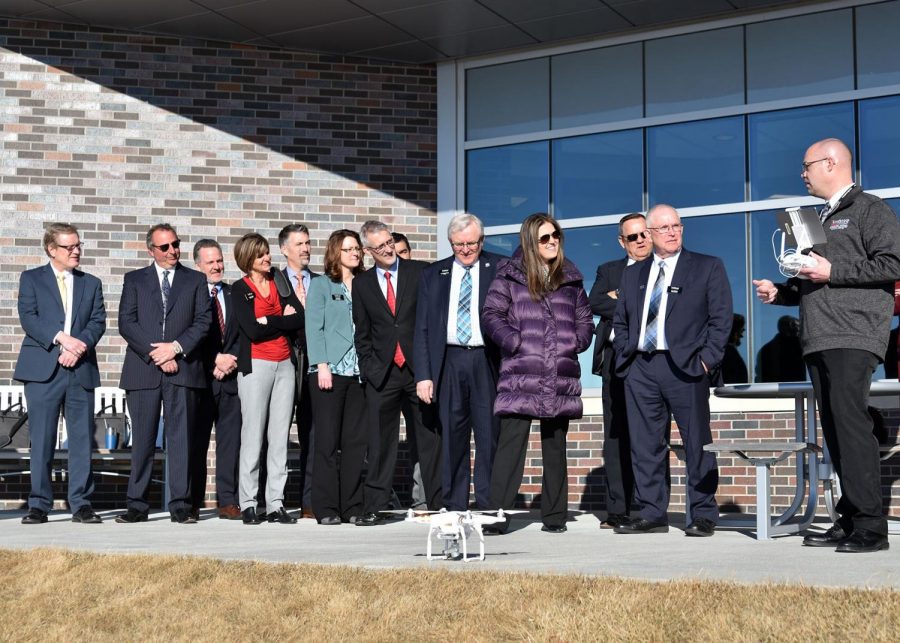New Northeast program to soar to new heights
March 13, 2018
NORFOLK, NE – Brian Anderson has been using cutting edge technology in his classroom for the past few years. Now the Northeast Community College broadcasting instructor is ready to take one particular method of technology to new heights.
“Our new Drone Operation class, that will launch in the fall, will instruct any student in any major on the rules and regulations of the FAA (Federal Aviation Administration) and also provide hands-on flight instruction in order to lead them forward in whatever major it is that they are going to pursue,” he said.
A drone is an unmanned aviation system (UAS) and can range in size from less than a half-pound object that can sit in the palm of one’s hand to super-sized drones that may be fixed-wing and as large as a bus. Northeast’s drones are somewhere in-between.
Speaking to members of the College Board of Governors during their monthly meeting Thursday, Anderson said many people think of drones as part of the military. He said while that is true, there are many commercial uses for the vehicles.
“In the broadcasting industry, approximately 50-percent of the nation’s TV stations are using them. Companies like CNN and the Weather Channel have been using them regularly and have worked with the FAA on how to use them while abiding by flight rules.”
Northeast has been using a DJI Phantom 3, which is a large durable drone with powerful motors and a global positioning system (GPS) that locks on to 16 different satellites.
Anderson said it’s very important to follow flight rules.
“If you fly a drone in the United States, it’s your responsibility as a pilot to understand and abide by the rules, especially if you’re going to be flying it for commercial ventures. If you make money off how you use your drone, such as selling photos you take with it, you have to be certified and know the rules of the air.”
After over two-years of research, Northeast began test flights across the college’s nearly 800-acre campus after contacting the manager of the Norfolk Regional Airport for clearance to fly. Anderson initially flew the test drone, which has a maximum speed of 35 miles per hour and blades rotating at 9,000 revolutions per minute (rpm), and captured spring planting on the college farm and demolition of the former buildings of the Norfolk Regional Center.
Anderson also worked with Steve Keiser, a military veteran who farms near Fordyce, who erected a large American flag in the middle of his corn field. The video of the drone flight has been shown at events across campus.
Anderson earned his certification to be a pilot from the FAA after he attended a drone journalism school at the University of Wisconsin-Madison, along with over 100 representatives from many large networks, television stations and other industries.
“I noticed when I was there, if a college or university had a class, it was a specialized class, like drone journalism or something in agriculture. There weren’t many classes being offered to any student of any program to just learn the rules and basic operation. This is why we developed the new class that we’ll launch in the fall.”
Anderson said his certification is necessary to teach the class.
“Now that we have drones, we thought it would be advantageous for us to create a class and offer it to students so they can start to learn how to fly these vehicles….not only for the television business, but we’re finding a lot of different industries starting to use them.”
Anderson has registered Northeast’s drones with the FAA and he has also created a drone operations manual which includes protocol on what one needs to take care of before a drone is launched. The manual includes logs and procedures as well as information on flight information and what do if something goes wrong.
Power and wind energy are among industries that have incorporated drones into their operations, designed to be used for inspections at critical heights. Northeast’s wind energy program has also been using a drone with students in its program.
Anderson said Northeast has been in contact with one company that is interested in having the College assist in training its employees with the basics of flying drones in its operations.
Drones have a number of uses including inspections of buildings, communication and utility towers, inspect for damage to areas and structures in hard to reach places, fly over disaster location sites, and mapping, among others.
Anderson said while it would be good for his students to be trained and certified in drone operations, the new class at Northeast will fit multiple programs of study.
“We are seeing them used in the broadcasting business right now. With the number of media outlets using them, it would be good that my students are certified upon graduation so they can go to work immediately. But it goes beyond that,” he said. “In addition to our media arts program, agriculture, criminal justice, and utility line are among those interested in incorporating drones into their curriculum.”
Anderson said the occupation is becoming lucrative. The Association of Unmanned Vehicle Systems reports that 100,000 licensed drone pilot jobs will be available by 2025, with strong income potential depending on the project.
Anderson stressed that the class coming this fall has been designed to be taken by any student, regardless of their program major.
“So whether they’re in utility line, wind energy, mass media or agriculture, this class will teach students how drones operate while they learn the rules of the road. They will then be able to apply that towards their specific major. The class will prepare them to get licensed by the FAA, which is the only agency that can certify and license drone pilots.”
The course will consist of a one credit hour class that will primarily focus on rules and regulations while another one credit hour lab will allow students to have flight time each week.
For more information on the new drone operations class beginning in fall 2018, contact the Northeast Community College Business and Technology Division at (402) 844-7741.











